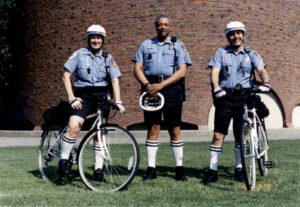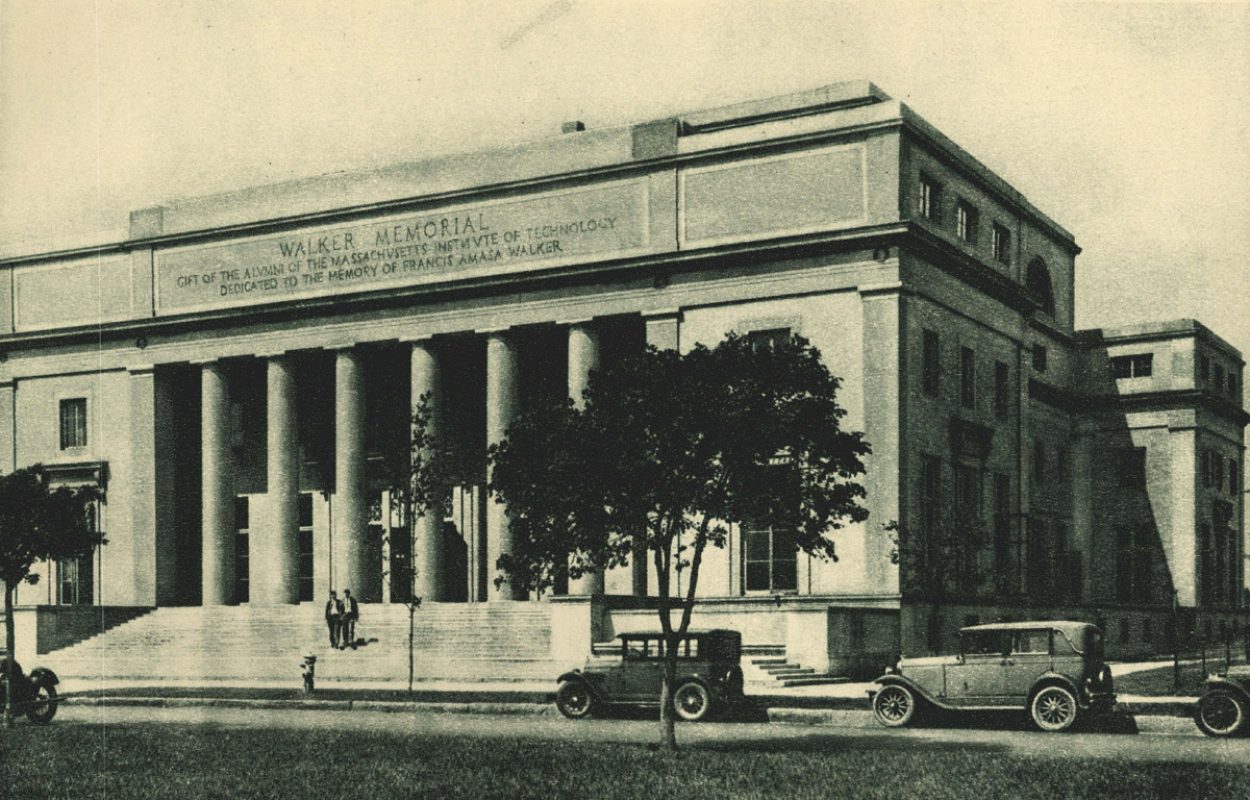MIT Police
History |
Organization |
Timeline |
MIT Security Force
The MIT Police originated in 1957 as a part of the Division of Sponsored Research (DSR). Prior to the creation of the campus police, security at MIT was performed only by one DSR security guard assigned to “Roving Academic Patrol” and a number of night watchmen. In January 1957, Harvey S. Burstein, Security Officer for the DSR, noted that this was inadequate, citing recent on campus thefts. Incidents occurring between students and the Cambridge Police Department may have also influenced the development of an MIT police force. Under Burstein’s oversight, 19 officers were recruited and trained in August 1957. That September, the Police Platoon of the MIT Security Force debuted on campus under the direction of Captain Norman S. Sidney, a former captain of the Massachusetts State Police. DSR guards were renamed the Guard Platoon and were also a part of the Security Force.
All members of the new police force were constables in Cambridge and carried firearms. In the beginning, many of the officers were retirees from the military or municipal police departments. The force had one cruiser, a 1957 Chevy station wagon, which also served as an ambulance. The Security Force was based out of building 20, wing C.
Campus Patrol
In 1960, an administrative decision split apart the two platoons of the Security Force. The police were renamed Campus Patrol and would now report to the Office of Personnel Relations. Security for sponsored research contracts would remain a part of the DSR Security Office under Harvey Burstein’s oversight.
As of 1969, the Campus Patrol was removed from the responsibility of Personnel Relations, and was now overseen by the Institute Vice President of Operations. Around this time, the staff had doubled from its original size. The force now consisted of 1 chief (Norman S. Sidney), 1 captain, 1 lieutenant, 4 sergeants, 35 patrolmen, and 2 secretaries. In April 1969, walkie-talkies were purchased for use by the Campus Patrol, and they shared a radio network with the Physical Plant. The Campus Patrol moved into a new headquarters in July, 1970. The new space was located on the second floor of the Armory (W31), and provided the force a larger space for staff and files.
Following the retirement of Chief Sidney, James Olivieri was promoted to Chief of Police on July 1, 1973. He began a Crime Prevention format, which included community outreach such as the MIT Junior Beavers Program and added services such as providing nighttime escorts. In 1974, the department formally started offering ambulance service. A Class 1 ambulance was purchased and all new recruits to the Campus Patrol were required to take EMT training. All officers hired prior to 1974 were trained as first responders. Around this time, control over parking began to shift from officers to civilian personnel. By 1976, Campus Patrol began performing Crime Prevention Tours to find and eliminate potential security risks.
Campus Police
The Campus Patrol (now called the Campus Police) began utilizing the Integrated Criminal Apprehension Program (ICAP) in January, 1980 – a program already being utilized by the Cambridge Police. In October 1980, the department held their first annual crime prevention fair. McGruff the Crime Dog was introduced to the MIT campus at this time. Also around this time, a Special Services Division was added to the force.
To further integrate with the surrounding police departments, the Campus Police joined the Boston Area Police Emergency Radio Network (BAPERN) in 1982. This allowed the MIT Police to communicate with Greater Boston police departments, including Cambridge and Harvard University. By October 1982, the campus police computerized their records.
On September 16, 1982, the Campus Police began distributing crime prevention packets to freshmen students. These distributions included a variety of informational packets, and would become an ongoing effort by the Campus Police
James Olivieri retired from his role as Chief on November 30, 1987. Captain Anne P. Glavin was appointed as Chief Olivieri’s replacement, becoming Chief of the Campus Police on December 1, 1987. Also beginning on December 1st, all new hires were sworn in as deputies in Middlesex County. In April, 1988, all police supervisors were sworn in as deputy sheriffs in Middlesex County.
In 1991, sensitive crime investigation was added to the responsibilities of the Crime Prevention Unit, which covered crisis intervention, harassment, sexual harassment, and rape. Also in 1991, two new crime prevention programs were initiated – the Crime Prevention Coordinators Network and Project Awareness. Both initiatives aimed to involve individuals on campus by engaging staff and student liaisons to disseminate crime prevention information and raise awareness. To further raise awareness, the police began publishing their “Crimewatch Log” in Tech Talk on a weekly basis, which would continue through about 2004. Police logs were also published in The Tech starting in 1993. Another crime prevention effort, Safe Ride, began during April, 1991. Two dedicated safety shuttles were operated by civilian personnel for nighttime escorts. This operation doubled in size by the end of 1992.

Barbara Haven, Raymond Roberts, and Robert Molino
As of June 1991, the MIT Campus Police Bicycle Patrol Unit began operations. The idea for a bicycle unit had been proposed the previous year by officers Barbara A. Haven and Robert J. Molino. Eight officers were trained at MIT, with the assistance of the Boston METRO Police. Patrols were conducted on two shifts, with no more than three bikes on patrol at a time. Officers on bicycles would cover a designated foot patrol area, replacing the walking officer for the shift. In July of 1995, a Motorcycle Patrol Unit was added to the police department. Both the bicycle and motorcycle units were a part of a Special Mobile Operations Patrol.
A new division was added to the department in 1998 – the Threat Management Unit. The intent of the division was to deal with potential workplace violence. In spring 1999, the police department expanded their patrol area into Boston to police MIT fraternities, sororities, and independent living groups.
In 2000, the Campus Police received new uniforms designed by Officer Willard J. Boulter. It was the first time the uniform had been changed since the department’s start in 1957. The new uniforms featured darker colors and a garrison-style hat. The police patch also received its 5th update, designed by Officer Paul F. Valentino.
Chief Glavin was promoted to Director of Public Safety on March 30, 2001, though she remained in the role of chief until her replacement could be found. John DiFava of the Massachusetts State Police was announced as Chief Glavin’s successor in September, 2001, and he was originally slated to begin in October. However, due to the events of September 11, 2001, he remained with the State Police for an extended period of time. John DiFava officially became MIT’s Chief of Police on December 10, 2001.
The Police at MIT
During Chief DiFava’s first year, command staff was restructured and lieutenants were responsible for 3 distinct areas: Patrol Operations, Community Policing, and Professional Standards. A mobile command post was introduced, and the bicycle and motorcycle units were redesigned as dedicated patrols. The Police also formed an Honor Guard under the direction of Lt. Daniel Costa. The Honor Guard wore a “Class A” uniform which included a special cross belt and garrison hat. The Guard made their debut in May, 2002 at the Cambridge Memorial Day parade.
In response to protests by students demanding confidential medical transports, the Police began to phase out their EMT service in 2002. They were replaced by a student-run service. In fall 1002, MIT institutes Campus Crime Watch, joining several other Massachusetts college campuses. Chief DiFava received a promotion in February, 2004, to Director of Security and Campus Police Services. In addition to his role as head of the Police at MIT, he would also be responsible for coordinating security issues on campus.
MIT Police
The MIT Police moved to new headquarters in building W89 on February 5, 2006; the new facility included an on-campus booking center. As of 2008, the MIT Police also operate a detail office within the Stratton Student Center.
Currently, the MIT Police is divided into two major administrative groups, Patrol Operations and the Special Services Division. Patrol Operations provides day-to-day policing and emergency services. Special Services encompasses three units: Investigation, Sensitive Crimes, and Crime Prevention. A third group, the Training Unit is managed by the administrative captain.
History, Organization, and Timeline researched and drafted by Christina Tanguay, 2014.
Photograph (undated) from MIT Office of the Senior Vice President, records of William R. Dickson (AC 525), Institute Archives and Special Collections, MIT Libraries.

